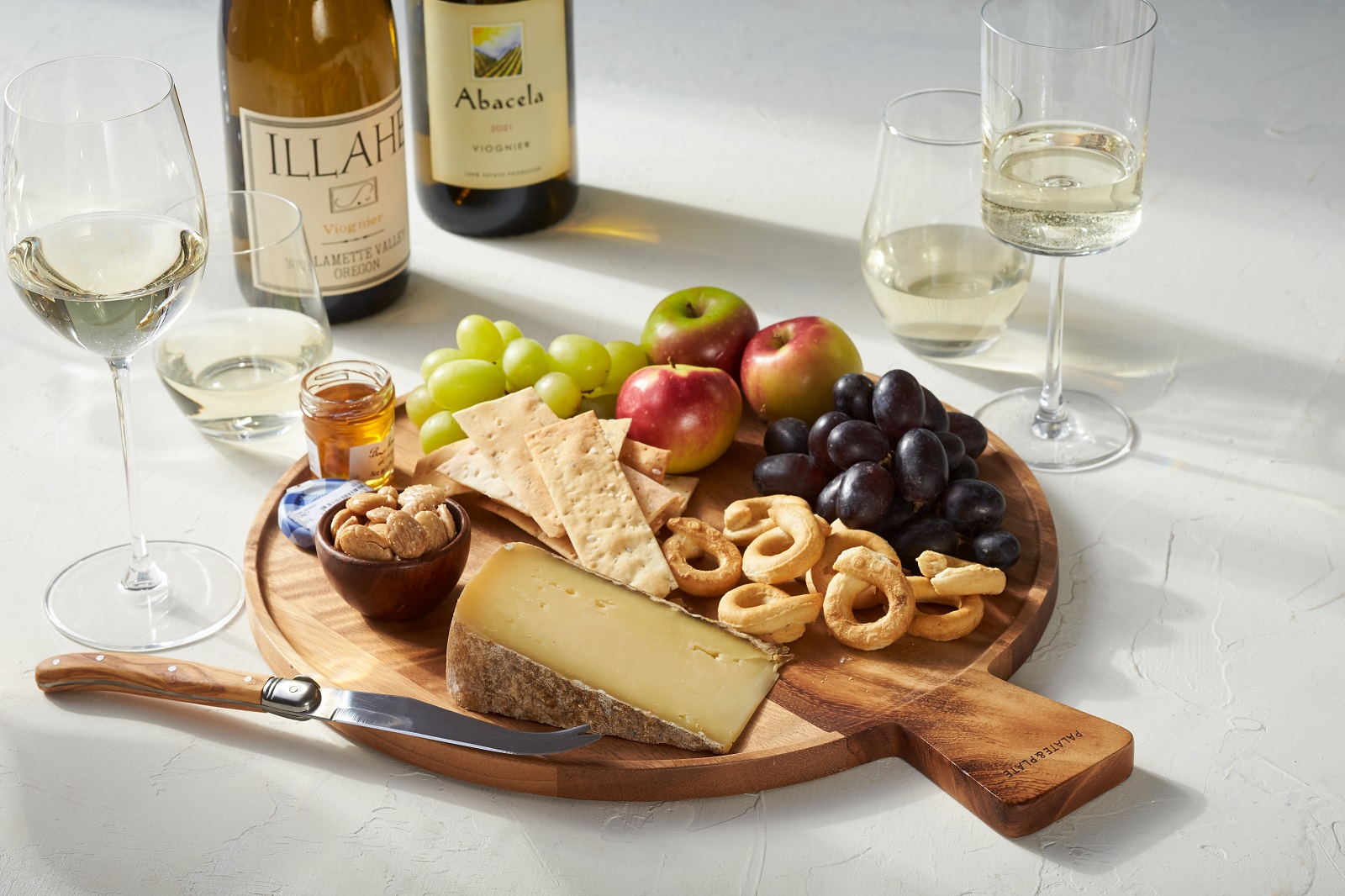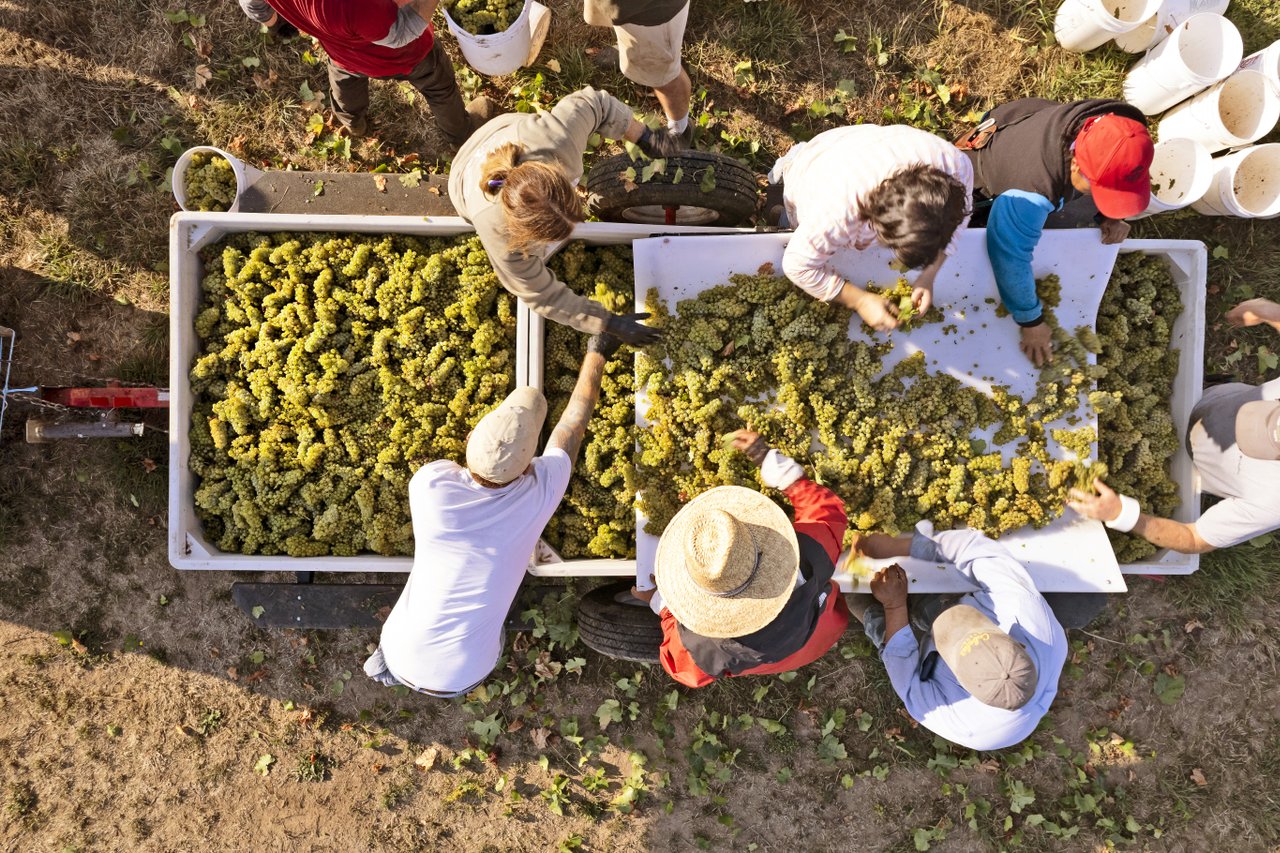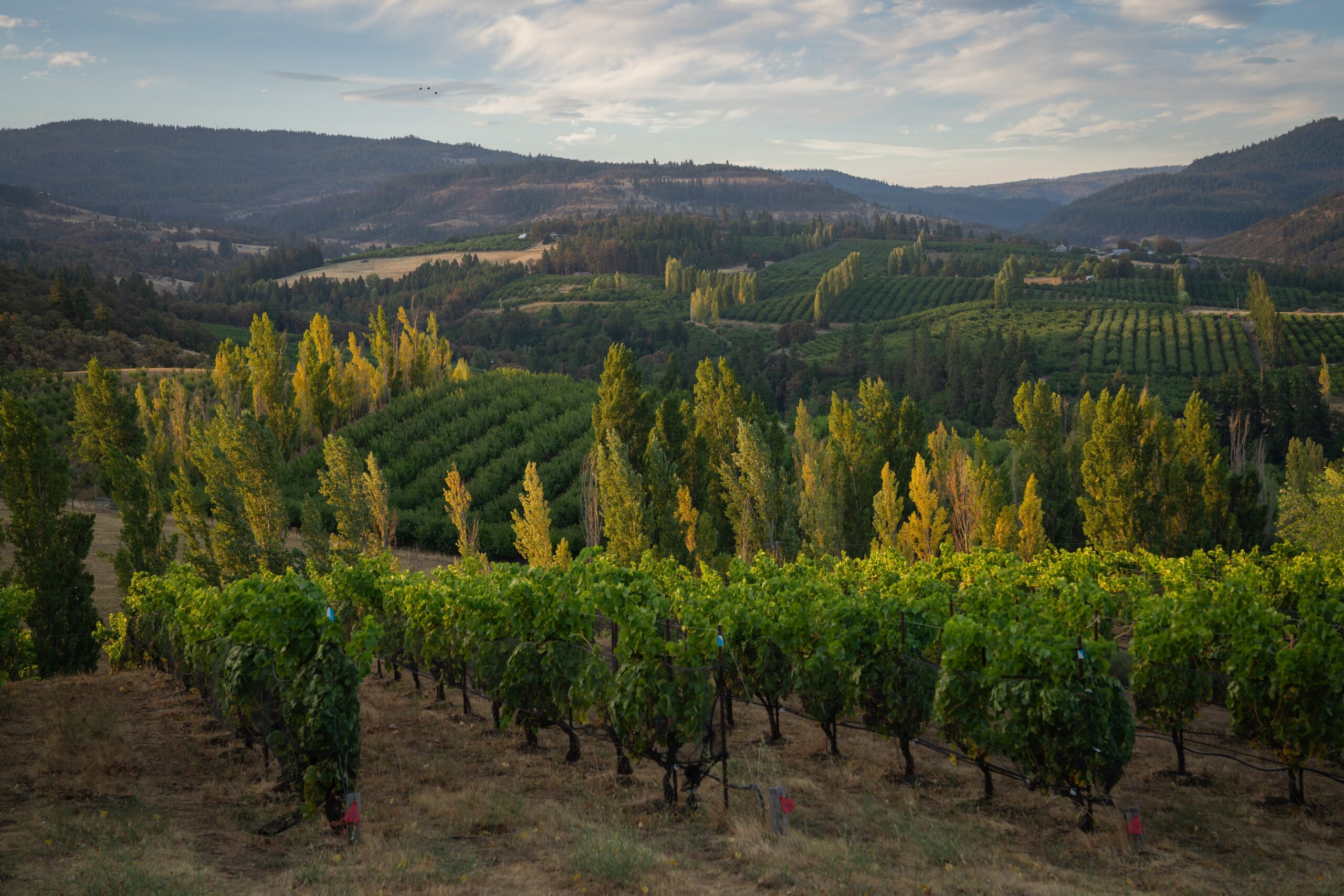By Kerry Newberry, Emily Teel and Margarett Waterbury
While Oregon’s wines are among the state’s most well-traveled agricultural exports, they are also a reflection of a robust edible ecosystem. As autumn harvest season gets underway, wild blackberries grow in the hedgerows and riparian areas that surround manicured vineyards. Orchards on the opposing hillsides are bountiful with apples, pears, plums and hazelnuts. Salmon and steelhead swim in rivers fed by the same rains that water the vines. In the intervening forests, wild mushrooms sprout from the vast mycelial network that also supports healthy vineyard soils.
These connections between agriculture, wild places, the edible and the wines of Oregon stretch throughout the state and encompass the entirety of the seasons. Tasting rooms serve sips year-round alongside locally made cheeses, breads made from locally milled flour and jams bursting with Oregon’s abundant berries. Restaurants revel in serving buttery Dungeness crab with Oregon’s bright Chardonnay. Even tasting notes reflect these connections — savory mushroom, cherry- red fruits, the flintiness of a Pacific oyster and the musky aroma of the earth itself.
And the best way to truly appreciate the dynamic flavors they have to offer is to enjoy them alongside something to eat. As the old saying goes, what grows together goes together. Oregon wines paired with foods that come from the same soil teach us more about both and allow us to appreciate the pleasures of Oregon wine country all the more.
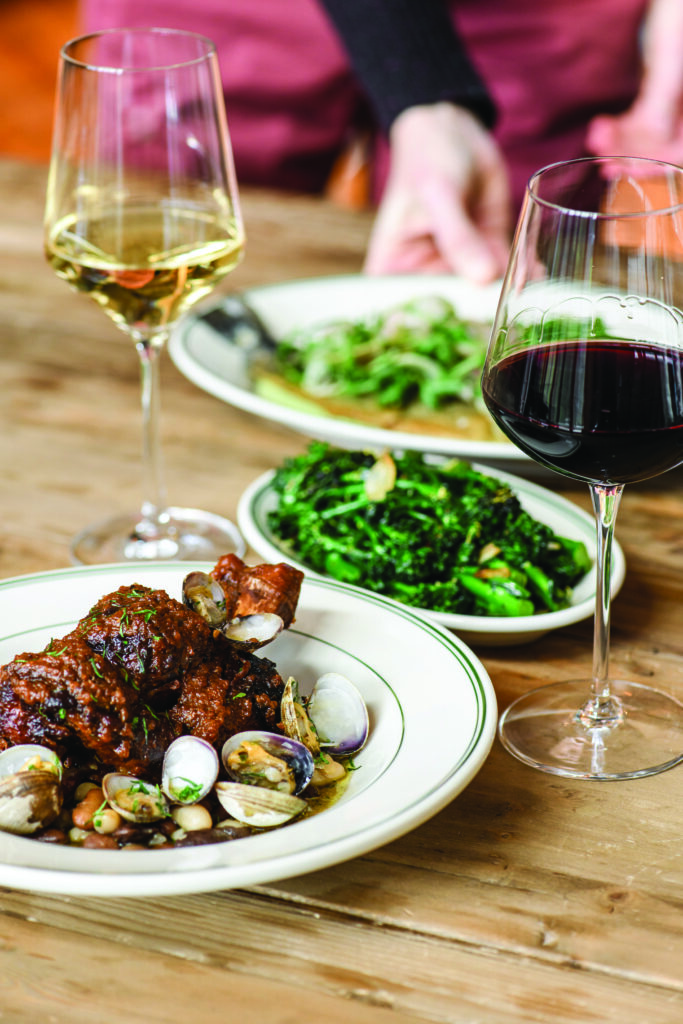

Portland
For food and wine enthusiasts, there’s no place quite like Portland. Much of the city’s culinary spirit has been shaped by the family farms and elegant vineyards that grew up around it. Add in the nearby forests brimming with wild mush-rooms and the bountiful sea and rivers, and the ingredients available throughout the year are nothing short of inspiring.
“The valley’s climate and tilth have given life to an unparalleled bounty for the kitchen and the barrel,” says Greg Higgins. When the chef opened Higgins in 1994, he quickly formed connections with the nearby winemakers — many still deliver their small-batch bottles directly to his door. In summer his chilled melon soup offers a refreshing match for one of the state’s crisp and citrusy sparkling wines. Come autumn the restaurant celebrates with a special forest-mushroom dinner featuring dishes like mushroom cappuccino and crispy goat-cheese pies with truffles and porcini — together offering a dreamy duet for the state’s earthy Pinot noirs and savory Syrah.
At the wine-driven restaurant Arden, executive chef Erik Van Kley builds his dishes with adven-turous wine pairings in mind. The wine list often highlights offbeat varieties and the state’s tiny, upstart producers. For example, Oregon Nebbiolo — rare, unexpected and delightful. Van Kley recently paired this ethereal red wine with a dish of seared Oregon albacore, heirloom tomatoes and a blistered shishito relish. “The pure-red fruit from Cameron Winery’s Nebbiolo perfectly matches the blistered peppers, smoked dashi, and the sweetness of the tomato and albacore,” says Van Kley. Other producers with a soft spot for this iconic Italian varietal include Remy Wines, Montinore Estate and DANCIN Vineyards.
For exquisite unions at one of the city’s most romantic spots, Quaintrelle always delivers. Chef de cuisine Ryley Eckersley makes an unctuous egg-yolk raviolo with chanterelles, hazelnuts, rosemary, brown butter and truffle that’s an aha moment when tasted with the state’s signature Pinot noir. “The earthiness of the mushrooms, the fat of the yolk, the complex salt from the Parmesan, the rosemary — all play so well with Pinot,” he says.
The chef also highlights the state’s sea-kissed oysters (creatively dressed with nuoc cham, fermented chilies, peach and shishito granita) with a wine geek’s dream, Maloof Wines’ Gewürztraminer, made by a husband-and-wife team with a penchant for aromatic white wines.
“The Gewürtz has great acidity and structure that accentuates the deliciousness of these flavors rather than compete with them,” Eckersley says. “It’s a really fun pairing!”
One of the most iconic ingredients in the state is the glorious chinook salmon from the Oregon Coast. “It’s impeccable with Pinot and morels,” says Gregory Smith of Noble Rot. He often grills the salmon with herbs harvested from the rooftop garden along with zucchini agrodolce and hakurei turnips. “Serving Oregon’s bounty and beauty on the plate and in the glass can be transformative,” he says.
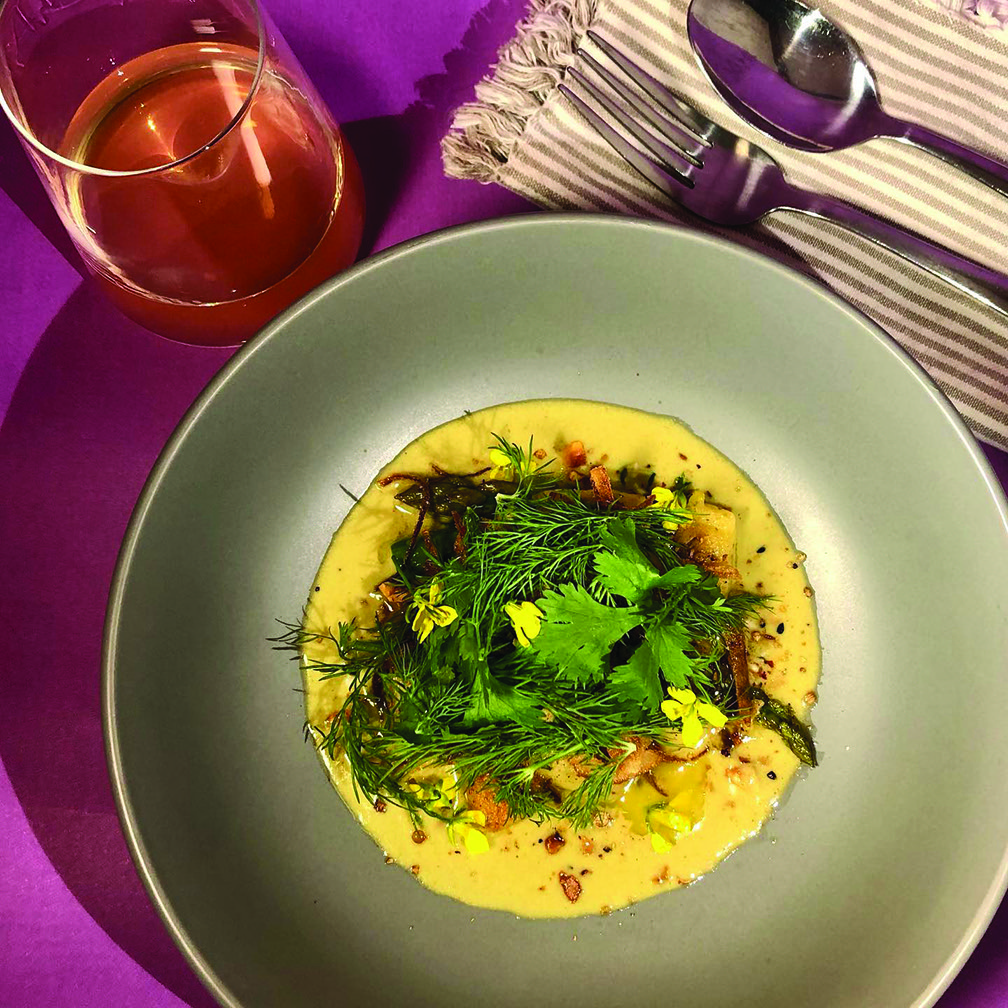
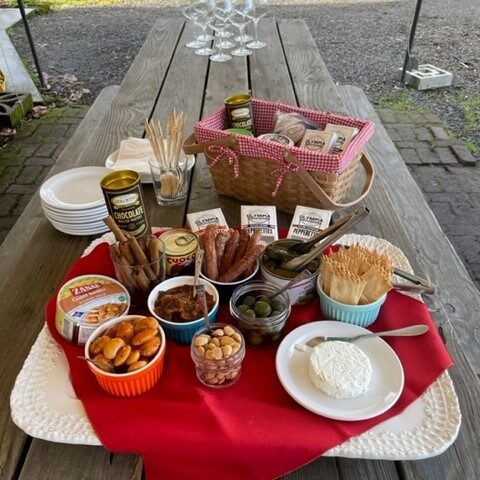
Willamette Valley
Oregon’s largest wine region, the Willamette Valley, is also home to the state’s most diverse and dynamic agricultural region. Growers cultivate berries, hazelnuts, honey, cereal grains, and loads of fruits and vegetables. Add a robust community of commercial foragers in the Cascade mountain range, and you’ve got a recipe for a vibrant local dining scene.
For many, velvety Pinot noirs and bright Chardonnays remain the region’s standard bearers, but some wineries are diversifying vineyards with experimental blocks of Gamay, Syrah, Riesling and other varietals — and local chefs create dishes that continue to inspire with every new bottle.
McMinnville has two new ambitious dining destinations that focus on the connection between land, food and drink. At Ōkta, Matthew Lightner — formerly of Portland’s acclaimed Castagna and two-Michelin-star Atera in New York City — serves a seasonal tasting menu with molecular gastronomy’s foams and sculptures.
The vibe is more casual down Third Street at Humble Spirit, where cellar workers mingle with visitors, who can enjoy a burger from the restaurant’s own pasture-raised beef alongside a glass of slightly chilled Pinot noir from J.K. Carriere called “atypical.” Humble Spirit’s director of hospitality, Andrew Mosblech, loves the classic complement of wild fungi or rich meats with Pinot noir, but he also pairs heritage-breed Tabula Rasa Farms pork with an up-and-coming varietal, Gamay, because the “bright acidity” and floral aromas do so well with its flavorful fat. For chef Brett Uniss’ grilled trout and green goddess-dressed herbs, he opts for a Grüner Veltliner from Martin Woods Winery or Evening Land Vineyards’ Chenin blanc.
Not far away, at McMinnville’s Mac Market, beverage manager Elaine Kim Heide likes to use Willamette Valley wines to enhance the spices in chef Kari Shaughnessy’s menu that bursts with flavors inspired by Southeast Asian, Indian and Middle Eastern cuisines. “A Brick House Pinot noir with simple roasted chicken and vegetables is a home run,” Heide says, “but you can also have an incredible Indian meal with the exact same ingredients, and the wine — a little earthy, spicy, neutral oak so the spice really shines — pairs beautifully.”
For guests who would prefer to quench the heat of a dish, Heide loves unexpected Willamette Valley whites. “I love whites with pretty flavors that are delicate aromatically, but on the palate they have length and intensity.” Favorites include The Eyrie Vineyards’ lightly floral Chasselas doré and the Pinot gris pét-nat from CHO Wines.
In the Southern Willamette Valley, Eugene’s thriving dining scene relies on favorites like Marché, where you can count on lush filets of chinook salmon with locally foraged truffles accompanied by a glass of Pinot noir from the vineyards just outside of town, or Lion & Owl, serving brunch with carefully curated bubbles and other wines from small Willamette Valley producers like Walter Scott in the Eola-Amity Hills.
Downtown, Party Bar shucks oysters at a tidy raw bar and offers upscale Pacific Northwest cuisine with a Southern touch, including plates of its renowned sweet-tea-brined fried chicken. Owned by a couple who love discovering new and unusual wines, the operation offers its best finds also at the adjacent retail and bottle shop, Party Market & Wine.
Recently, co-owners Tiffany Norton and Mark Kosmicki have been enjoying Fossil & Fawn’s surprising Gewürztraminer — whose tannins developed over 200 days of skin contact enhance their locally raised chicken — and an Alsatian-style white field blend that has “a really rich body that makes it good with locally grown, roasted win-ter squash,” according to Kosmicki. The Marigny’s copper-colored carbonic Pinot gris has been a favorite glass pour, complementing everything from oysters to seared albacore. “It’s got a lot of fruit like a good white but also a great tannic structure,” he says.
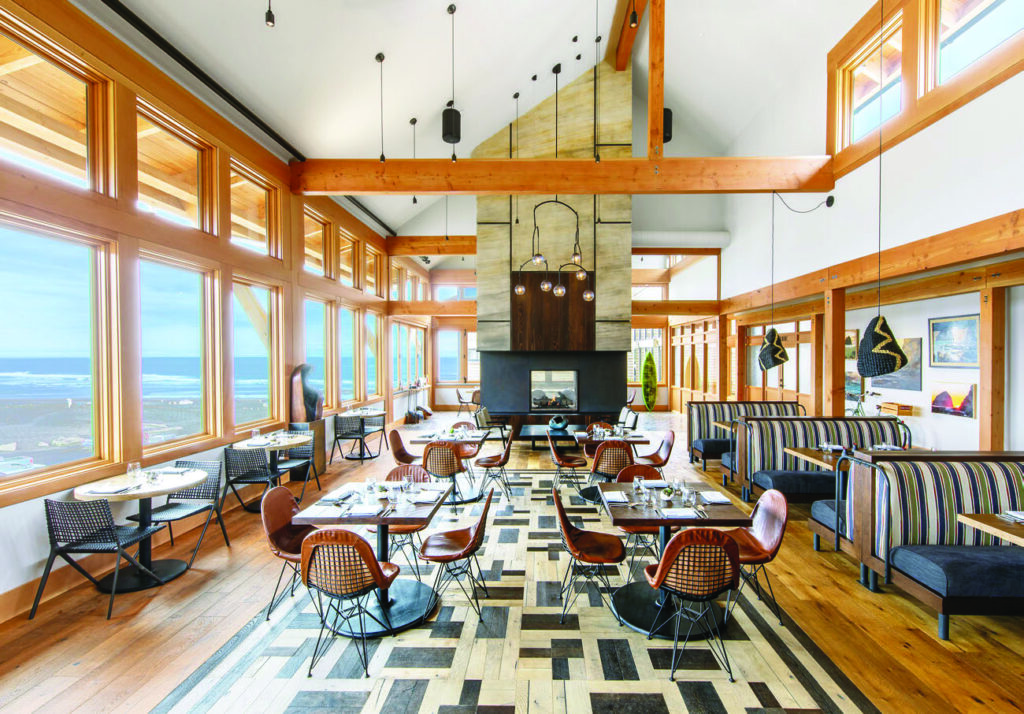
Southern Oregon
Bountiful Southern Oregon grows more than 70 different grape varieties. With a thriving tree-fruit industry, hundreds of small-scale vegetable and livestock farms, forests filled with game and wild mushrooms, and some of the best fly-fishing rivers in the nation, its culinary landscape is equally diverse. All these options make pairing wine and food here a particular pleasure.
“The wines in Southern Oregon are really friendly to pair with food because they have this beautiful acidity throughout, because of our special climate here,” says Jessica Colburn, co-owner and wine director at Decant, a family-owned fine-dining restaurant in Medford with an expansive wine program. “We have so many different micro-climates and elevation levels and soil types.”
For a classic Southern Oregon combination, Colburn suggests pairing a traditional-method sparkling Chardonnay like Maison Jussiaume’s Brut Blanc de Blancs with dishes that meld sweet and savory flavors, like a tartlet with caramelized onions, pears and locally made Rogue Creamery blue cheese. Still Chardonnay is another great pairing for local pears and apples, says Colburn, since the two can have similar notes.
If you’re feasting on fresh steelhead pulled from the Rogue or Umpqua, Colburn says aromatic whites like Vermentino, Albariño or Torrontés can be a good choice — but so too can lighter-bodied, thinner-skinned red varieties like Pinot noir, Sangiovese or Barbera. Heavier local reds like Cabernet franc and Petite sirah shine with flavorful wild game like rabbit or duck, which are complemented by dark-fruit flavors and more structured tannins.
Southern Oregon’s viticultural diversity also extends to winemaking. Wines inspired by the traditional winemaking techniques of Europe rub shoulders with provocative modern bottling that push the envelope in terms of sustainability, philosophy and flavor — sometimes all in a single producer’s portfolio.
At MÄS in Ashland, chef Josh Dorcak is particularly inspired by local wines that surprise. “When wines don’t follow their traditional character, you’re mentally engaged differently. You’re more open to possibility,” says Dorcak.
He loves serving orange wines like biodynamic producer Troon Vineyard’s Kubli Bench Amber in MÄS’ multicourse paired menus. “I think orange wine just has more substance and character behind it. It lasts a little longer and hits a different part of your palate,” says Dorcak. Slightly softer acidity also makes it easier to pair with very savory or umami flavors, like tomatoes or uni.
Plus, he says customers love the change of pace: “It’s totally different from what you had prior, so you’re engaged. It’s intellectual. You’re in it.” A pretty good microcosm, in other words, for the many delightful surprises of Southern Oregon wine.
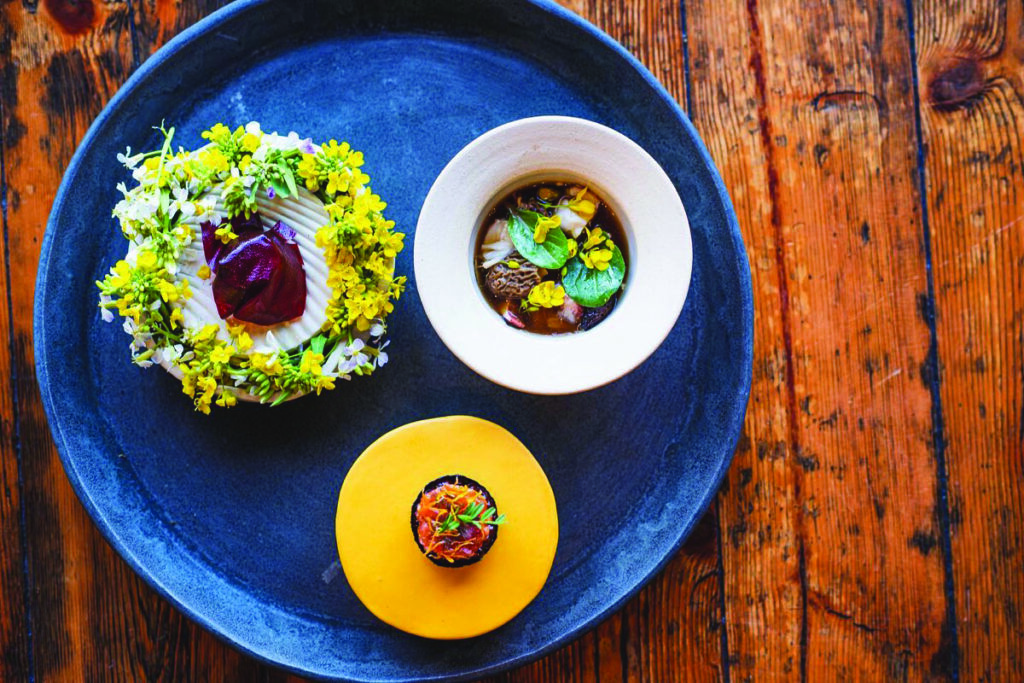
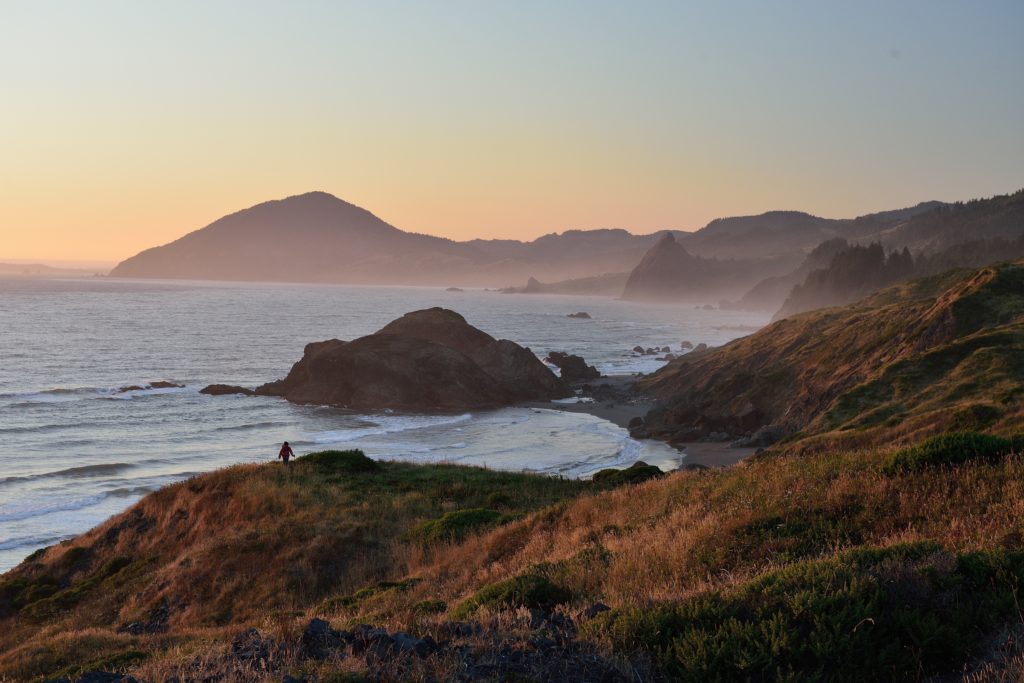
Oregon Coast
Year-round cool temperatures and a short growing season mean it’s a challenge to ripen wine grapes on the Oregon Coast. Still, the Pacific Ocean plays a key role in the climate of all of Oregon’s wine-growing regions. Many wines from cool and near-coastal sites — such as those in the Elkton AVA in the maritime western reaches of the Umpqua River — are often natural pairings for the crown jewel of Oregon Coast cuisine: seafood.
At Local Ocean, an employee-owned seafood restaurant in Newport, many meals start with fresh raw oysters. “No surprise here: I prefer to pair them with a nice dry bottle of bubbles,” says bar director Colt Deitrick. “Sokol Blosser makes an excellent Bluebird Cuvée brut sparkling wine that has just the right levels of acidity and minerality to complement the natural flavor of an oyster — and I love the contrast in textures as well.”
Another flagship bivalve of the Oregon Coast is the razor clam. John Nelson, culinary adventure director at Headlands Coastal Lodge & Spa in Pacific City, grew up digging razors to make extra money as a high school student in Astoria. Today he says these meaty, succulent bivalves are a perfect excuse to drink one of his favorite wines. “With razor clams, I love a good dry Pinot blanc,” says Nelson. “And in the Northwest, we produce some impeccable Pinot blancs.”
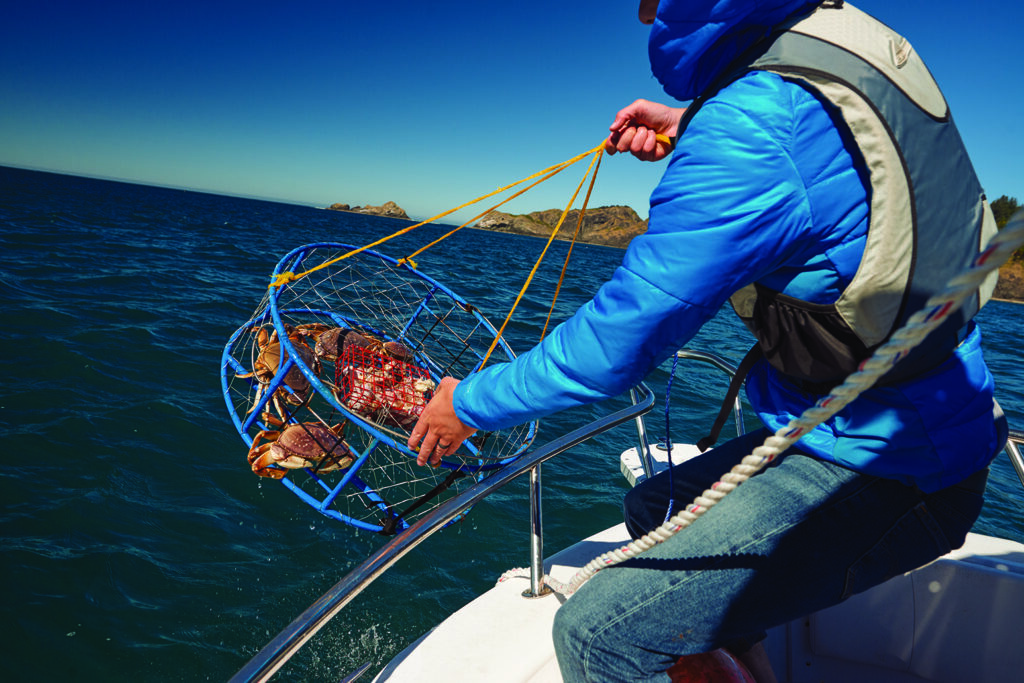
One of those is Teutonic Wine Company’s Alsea Blanc, a 50/50 blend of Pinot blanc and Pinot meunier made from fruit grown in Alsea, just 22 miles from Waldport, at a vineyard co-owners Barnaby and Olga Tuttle planted in 2005. It’s great with razor clams, and it’s so delicious with crab that Teutonic actually put one on the label. “It’s my dream wine for crab,” says Barnaby. “It’s a cold vineyard, so there’s really fierce, raging acidity and a clean minerality.”
Another high-acid, aromatic white wine that complements the sweet flavor of Dungeness crab is Willamette Valley Sauvignon blanc. “I prefer to recommend a lovely Sauvignon blanc from Andrew Rich Wines,” says Deitrick. “I find it has just the right balance of acidity, herbaceousness and spiciness to really do double-duty and pair well with either steamed crab or some of our delicious crab cakes.”
White wines are often the default for seafood, but they’re not the only option. “I know a lot of people don’t do reds with salmon, but I do,” says Eric Hill, executive chef at Meridian Restaurant & Bar at Headlands. “I like to contrast a good Pinot noir with a very full body with the freshness and salinity of the fish.” Try a Pinot noir from Brandborg Vineyard & Winery in the coastal Elkton AVA or one from Johan Vineyards or Björnson Vineyard in the Van Duzer Corridor AVA. This Willamette Valley sub-AVA is named for a low section of the Coast Range that allows cooling ocean winds to sweep inland. The grapes may not have grown within view of the Pacific, but it still played a key role in the character of what ends up in your glass.
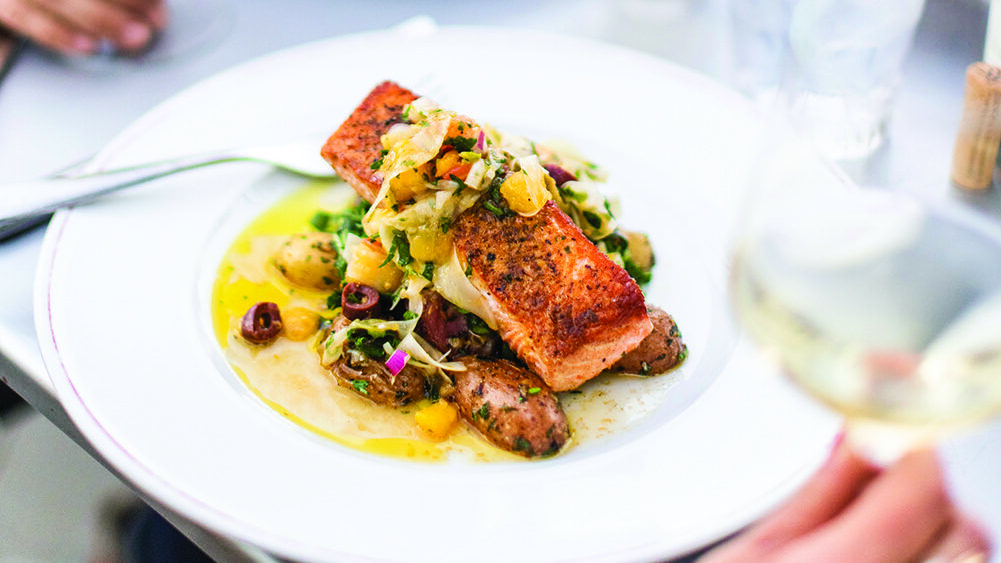
Columbia River Gorge
An astonishingly beautiful stretch of evergreens, waterfalls and basalt cliffs that burst with wild-flowers each summer, the Columbia River Gorge is one of the state’s most enchanting outdoor destinations. Often heralded as “a world of wine in 40 miles” thanks to the diversity of varieties that thrive here — everything from Albariño to Zinfandel — this pocket is also abundant with long-standing family farms, multigenerational orchards, artisan cheesemakers, chocolatiers, beekeepers and bakers. It’s one of many reasons chef Mark DeResta of Hood River’s Riverside restaurant has called this place home since 1994.
“The seasonal ingredients, along with the incredible wines made here, are nothing short of spectacular,” says DeResta. Riverside recently opened a wine lounge and offers a focused menu of glass pours from the Columbia Gorge AVA. “It plays into our menu, which is all about sup-porting local farms and producers,” he says. For him, the bounty of the Gorge bursts to life with the spring run of chinook. He pairs the succulent fish with punchy red Mencía, a rare Spanish varietal that was first planted stateside in the Columbia River Gorge by Analemma Wines.
At peak summer, DeResta’s popular Pasta alla Norma stars eggplant, tomato and basil from Stepping Stone Farm, a small organic grower located on land owned by Idiot’s Grace, a family-run winery comprised of hardcore home cooks — also a prime example of this close-knit culinary community.
“Our most anticipated dish every summer is a peach-burrata salad,” he says. The peaches come from the nearby Peachwood Orchard, where husband-and-wife orchardists grow over 20 unique varieties of stone fruit. On a warm summer night, the chef finds nothing hits the spot more than this medley of sweet and savory paired with a crisp white wine like Grüner Veltliner. “You can eat on the riverfront patio and watch ospreys dive for fish,” DeResta says.
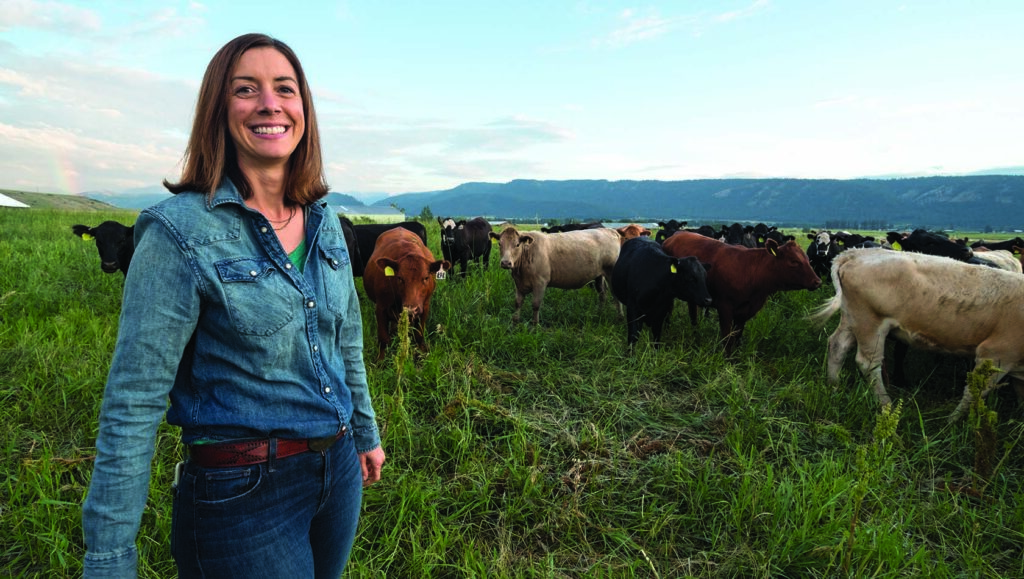
At 6,000 feet, up in the snowcapped peaks of Mt. Hood, Timberline Lodge has long enticed skiers, snowboarders, hikers, and food and wine lovers with ample dining options and an impres-sive cellar stocked with Oregon wines. “The late-summer season is perhaps my favorite time of the year in the kitchen,” says chef Eric Laslow. “We’re still in the thick of our warm-weather crops but just starting to edge into our fall fruits, vegetables and foraged foods.”
When the long-anticipated local tomatoes are abundant and Hermiston-grown melons are sweet and ripe, Laslow turns these peak-season flavors into a refreshing watermelon gazpacho. “It’s spicy and fruity and incredibly refreshing,” he says. “Add a glass of Oregon Riesling and this might be a perfect way to finish a late-summer day.”
Once the leaves begin to change, he starts planning for the earthy autumn flavors ahead.
“I’m a fan of simply sautéed chanterelles with butter and thyme,” Laslow says, “maybe dressed up with some baby beets that I’ve roasted with coffee beans.” Accompanied by a glass of Pinot noir or a fruity Gamay, you have a quintessential Oregon dinner that speaks perfectly to the season and place.
High Desert (Central and Eastern Oregon)
The sunny summers and white winters in the high desert in Central and Eastern Oregon are beloved by mountain bikers and skiers, but the temperature extremes that come with the terri-tory mean that the region’s winemakers must be of equally hearty stock. The young and up-and-coming regions in Central Oregon and Eastern Oregon’s Snake River Valley and Walla Walla Valley AVAs are still developing the future of these transformative regions.
The payoff for off-the-beaten-path winemakers is tremendous because of the region’s potential connection to a hugely popular agricultural product: beef. These regions are home to some of Oregon’s finest pastureland and many family-owned cattle ranches. Maragas Winery in Culver is beloved for bottlings of Tempranillo, Malbec and Petit Sirah, all poised to suit steaks for the cattle raised on the region’s many ranches.
Winemaking pioneers in Central Oregon include Faith Hope & Charity in Terrebonne, where the winery’s estate vineyard grows hybrid grape varieties that are cold-hardier than their viniferia counterparts. Some of these lesser-known grapes — Marechal Foch, Marquette and Léon Millot — boast big berry flavors. Winery staffers like to bring these to enjoy with steaks at Zydeco Kitchen & Cocktails in Bend or duck cassoulet at Becerra’s on 6th, Redmond’s French bistro. Winery ambassador Lynn Fox frequently brings the winery’s estate-grown white, a blend of La Crosse and Frontenac gris, to enjoy with the tom kha, the coconut and lime-leaf soup, at Wild Rose Thai in Bend.
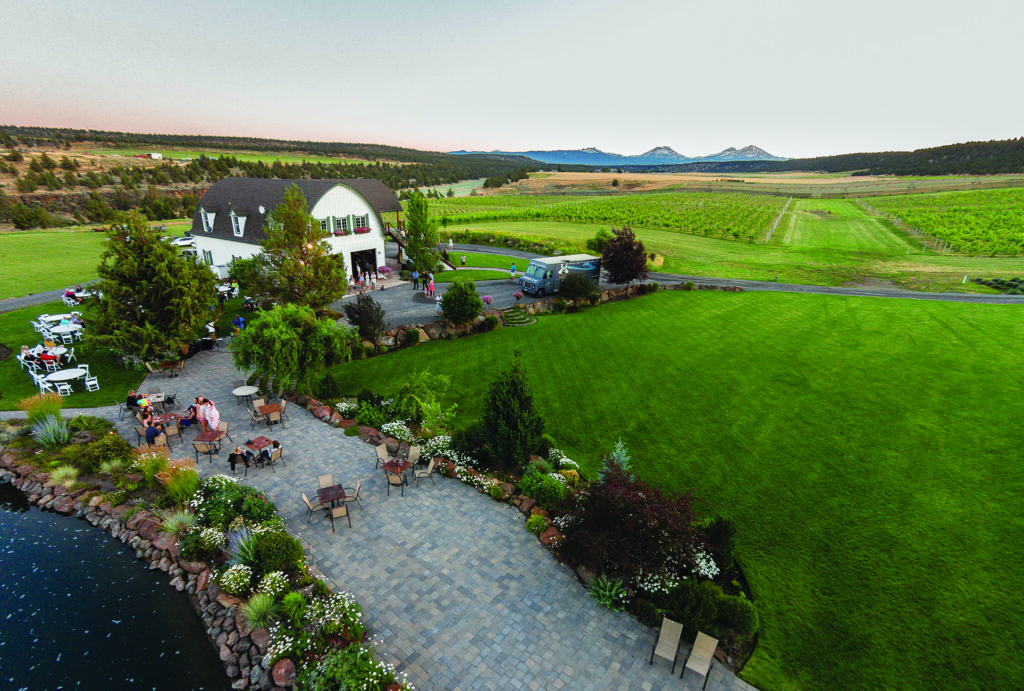
Matt Hensel, the sommelier and owner of Portland’s 45th Parallel Wines and Wines on 2nd in The Dalles, grew up in Hermiston and loves to celebrate the region’s Syrah, especially that grown on the Oregon side of the Walla Walla Valley AVA in the Rocks District near Milton-Freewater. There’s a misconception, he says, that the region only makes big, jammy, fruit-forward wines, but he likes to highlight a particular type of Syrah from the area.
“The rest of the Columbia Valley has really rich soil. It gives wines plenty of nutrients and they go crazy, but vines like to struggle. The Rocks has that perfect combination where the vines have to fight a bit,” he explains, and the resulting Syrah “doesn’t taste like Syrah from anywhere else.”
Wineries working with this fruit are making Syrahs in a rustic, earthy style, Hensel says, with aromas like “leather, meaty pastrami and black pepper. That’s how the Rocks District has really set themselves aside. It really is an exceptional piece of land.”
Hensel recommends showcasing Old World-style Syrahs from Rasa Vineyards and Grosgrain Vineyards alongside Eastern Oregon lamb.
“Lamb is an iconic pairing for Syrah, and there’s a long history of pastured sheep all over Eastern Oregon. It’d be fun to do a Mediterranean-style dinner with Hermiston watermelon salad with feta, grilled lamb and some slow-grilled Walla Walla sweet onions. Maybe add some blue cheese and thyme — Syrah stands up really nicely to big, bold cheeses.”
In Eastern Oregon, the Snake River Valley AVA is among Oregon’s youngest and most up-and-coming wine regions. The continental climate — similar in style to that of Eastern Washington — favors fuller-bodied grapes like Viognier and Syrah. Enterprising winemakers like Travis Cook of Copper Belt Wines in Baker City are finding success making both blends and single-varietal bottles.
“We raise a lot of beef here,” says Cook, and local beef cuts “go great with our wine.” He particularly likes a New York steak with Copper Belt’s Tempranillo. “We’ve got an acre and a half planted in really chalky soil, and the tannin comes through super silky. It’s great with red meat.”
This article appears in the 2023-24 Oregon Wine Touring Guide. Order your free copy today.
